NEWS
The Gnome Man
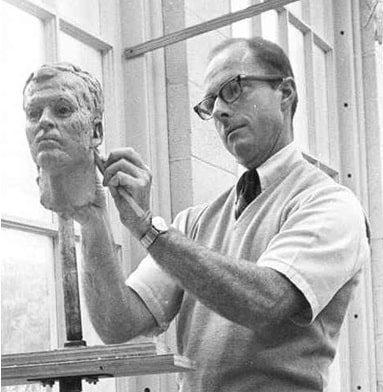
Thomas Fetzer Clark (Photo courtesy of Archives and Special Collections, Davidson College)
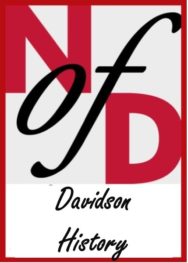 Beginning in the late 1970s, Thomas Fetzer Clark, known locally as “Tom” or “T-bird Tommy,” began a second career that would make him famous around the world. Clark grew up in Elizabethtown, North Carolina, and graduated from Davidson College in 1949. He then received a bachelor’s in divinity from Union Seminary in Richmond and a Ph.D. in theology from the University of Aberdeen in Scotland. Throughout these years, however, he also displayed a fondness for art. According to the Davidson College Archives’ Encyclopedia, he confessed that he “used to sit sketching in my notebook in classes while other people were writing what I should have been writing…My friends all know that I am an indefatigable artist. I can’t sit still without sketching.”
Beginning in the late 1970s, Thomas Fetzer Clark, known locally as “Tom” or “T-bird Tommy,” began a second career that would make him famous around the world. Clark grew up in Elizabethtown, North Carolina, and graduated from Davidson College in 1949. He then received a bachelor’s in divinity from Union Seminary in Richmond and a Ph.D. in theology from the University of Aberdeen in Scotland. Throughout these years, however, he also displayed a fondness for art. According to the Davidson College Archives’ Encyclopedia, he confessed that he “used to sit sketching in my notebook in classes while other people were writing what I should have been writing…My friends all know that I am an indefatigable artist. I can’t sit still without sketching.”
Since Davidson had no fine arts department at the time, he turned to other schools to train as a sculptor, including the Roberts School of Art in Aberdeen, the Museum School of Art in Boston, and at City and Guilds of London School of Art.
In 1958, Dr. Clark joined the faculty of Davidson College, where he taught theology and Christian art. Because of his intelligence and sense of humor, his classes were soon in demand.
According to a memorial published on the college website at the time of Clark’s death, “he was very simply one of the most popular professors ever to walk the halls and enlighten the classrooms of the iconic Chambers Building. In the classroom his performances were the eclectic mix of William Shakespeare, Don Quixote, and Woody Allen. For some it was pure academic delight; for others a life changing experience, but for all it was more entertainment than anything else AND it was Great Entertainment. He knew every student by their full name and quite a bit about each individual. And more than anything else wanted to be your friend as well as your mentor. He always had impeccable manners and always knew the right thing to say – never condescending – and was always positive and encouraging in his associations with students.”
In 1978 Clark, inspired by Rien Poortvliet’s illustrations in Will Huygen’s 1976 bestselling book Gnomes, he sculpted his first small gnome. This was followed by sculptures of other small forest-dwellers which he called “Woodspirits,” in celebration of their harmony with the natural world. The clay he used in the early days was actually dug from a creek in the middle of Patterson Court. Dr. Clark left Davidson College in 1985 to devote his time to the Gnome business with Cairn Studio.
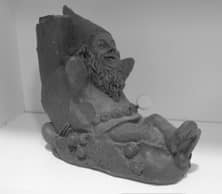
Saturday (Photo by Nancy Griffith)
By the 1980s, when we lived here, he had a studio on Main Street where you could purchase finished gnomes and unpainted ones to finish at home. Following his careful instructions, we bought an unfinished figure of Santa and painted, stained, and sealed it; it was a fixture of Christmases at our home for many years.
As he told an interviewer, “I am a creative person, and sometimes creative people like me don’t fit in well in structured organizations like colleges. For me, it is very satisfying to have people come into my Davidson shop or into a dealer’s and pick out a statue because they like it. They’re not just coming to see me because they’ve run out of the permitted class absences for the quarter.”
Clark’s figurines were much different than those mass-produced in factories in Asia, which were often presented as hand-crafted. His creations followed strict production rules, were limited editions, and were subject to stringent quality control standards. The first step in the complicated process was making the mold. The nature of the mold determined its life; thus sculptures were limited to the number allowed before the mold broke.
Figures were then cast, and the seam lines were sanded down. Next the figures, all signed, numbered, and dated, were washed in a solvent to prepare them for painting. Painting was done free-hand, and then the figure was dried, antiqued with a special stain, and then wiped and hand-brushed. The face was buffed with water and thinner to make details like laugh lines and wrinkles jump out to reveal the distinct personality. Then the completed product was coated with a special sealing agent.
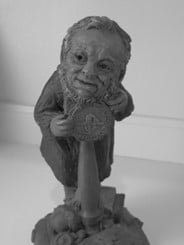
Chalmers (Photo by Nancy Griffith)
Clark was known in Davidson for his gnomes depicting local people. In 1980 he produced a sculpture honoring Chalmers Davidson, college librarian and later college archivist.
According to Cairn Studios, Clark “imbued every creation with his personal philosophy that “the universe is basically friendly.” His Gnomes and Woodspirits “show a dignity that comes from a life of worth,” and he felt that his creations were successful if they made you smile.
Clark’s gnomes soon became wildly popular, and were coveted by collectors across the United States, Europe, Asia (especially Japan), and Canada. The registered collector base included such notables as Barbara Bush, Bob Newhart, Stephen King, Alan Alda, Ed Harris, Candice Bergen, Dean Smith, Arnold Palmer, Charlie Daniels, and the members of “Alabama.”
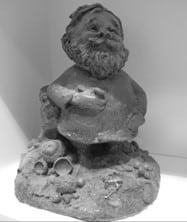
Other Davidson employees also appeared, including Ruben, fashioned after longtime Davidson College plumber Ruben McIntosh (Photo by Nancy Griffith)
At one point the magazine Giftware News declared him to be “already bigger than Norman Rockwell – an American Treasure.” In addition to his gnomes, Clark also produced scaled miniatures of notables like Thomas Jefferson and Davy Crockett, as well as over 100 large portrait busts, including bronze sculptures of King David, Abraham Lincoln, and Beethoven.
His Davidson College memorial notes: “No one worked as hard as Tom Clark. He was a demanding task master. His labor of love brought him to collectors during the weekends and to a sculpting table during the week.” He told the interviewer, “I work very hard. Sometimes I feel the collector doesn’t quite understand just what it takes to do what I do – the sculpting and the personal appearances. But that is OK. I have often said it has taken me a lifetime to create any one sculpture. I am very pleased that in my life, I have been able to give something of myself, particularly my philosophy, that basically we are all part of the same world and ALL good at heart. To be aware that so many people are pleased to receive my work is the most reward in life I need. For people not to know what it really took to get here, it doesn’t matter.”
Tom Clark died in January 2022
Nancy Griffith
Nancy Griffith lived in Davidson from 1979 until 1989. She is the author of numerous books and articles on Arkansas and South Carolina history. She is the author of "Ada Jenkins: The Heart of the Matter," a history of the Ada Jenkins school and center.


